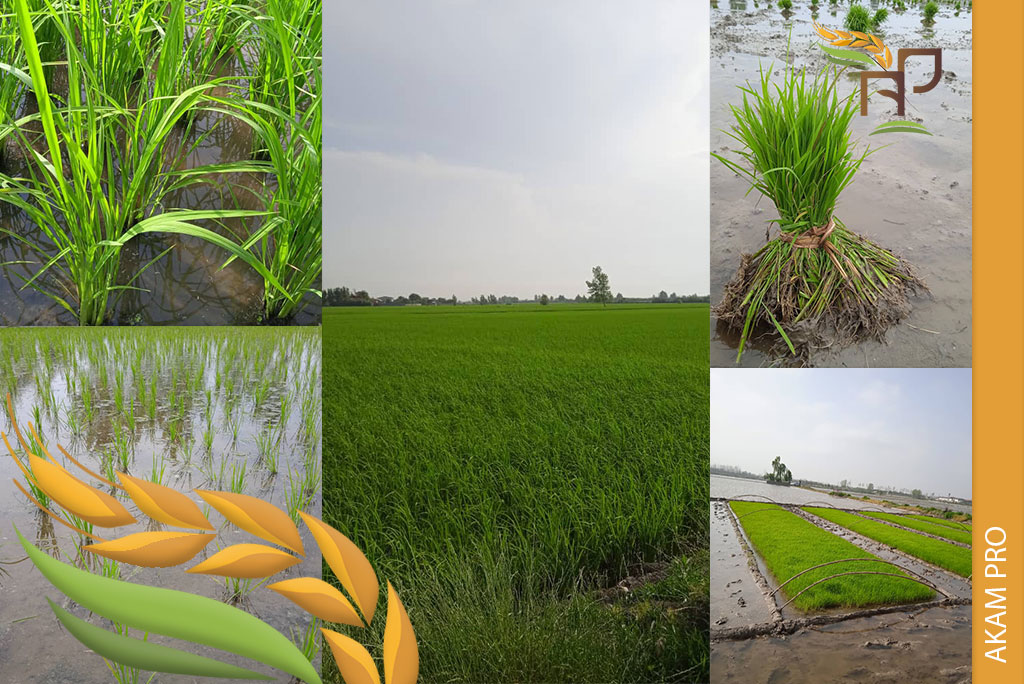When you bring rice to the table and eat, do you think how this delicious food got to you? Are you familiar with the steps of planting rice? The rice that reaches the consumers has gone through steps to reach the cooking stage. AKAM PRO is proud to offer its products to the customers with the highest quality and health from planting to eating. In this summary, we try to explain rice planting in simple language (traditional history with local phrases).
land preparation
Before planting rice, a suitable land must be chosen for it. It is better if this land has an independent water inlet. Rice field should be plowed in three stages. The first stage is three weeks before transplanting, the second stage is two weeks and the third stage is one week before transplanting. A tiller or tractor can be used to plow the rice field.
Preparation of rice seeds
Preparation of high-quality seeds is one of the important and basic steps in planting rice. Usually, most rice farmers keep some of their rice crop with paddy every year to use as seed for the next year. This rice must be kept in standard conditions so that they do not suffer from pests and rot. The seeds should not be exposed to moisture or strong light because they may be attacked by insects or rot. If the seeds get spoiled, usually the farmers have to get the seeds they need from somewhere else.
Preparation of rice sprouts
One of the stages of rice planting is seed germination. To prepare the sprouts of rice, first, they pour the rice into a large container or basin made for this purpose and fill the inside of the basin with salt water. The concentration of salt in water depends on the type of rice (With or without ribs) but they usually add 3 or 4 kg of salt for every 18 liters of water. This process cleans the seeds. Because the thin and light seeds are placed on the surface of the water and the heavy and healthy seeds settle down. Thus after this process, only the seeds that can be shipped and will germinate will remain.
After this stage, healthy seeds are put in special bags and placed in water to germinate rice seeds. Of course, you should be careful not to full fill the bags because the volume of rice paddies will increase by absorbing water and may tear the bag. During this period, do not let the water in the pond dry up and pour water into it constantly. This stage of planting rice is not finished yet. After 2 to 3 days, the seeds are spread on the ground in front of the sun and covered with a felt cloth to germinate. After about a week, the rice sprouts are ready.
Preparation of rice seedlings
After germination, the seeds should be transferred to the main land to prepare rice seedlings. For this purpose, a part of the main land is prepared, which is called treasury. Tom Bijar is prepared in such a way that a part of the field is fenced and plowed and the required fertilizers such as animal manure, nitrogen or phosphorus are poured on it. This is done in late autumn.
In the beginning of winter, the treasury is filled with water and it is made into a uniform flower in two ways; One is to use a tiller or an iron bull and the other is to use a kick to grind the ground. They do this until the ground of the treasury turns into watery buttermilk and is ready to receive the transplants.
Finally, the surface of the tank is completely smooth and uniform, and it is covered with a thin layer of water (about 3 cm). They sprinkle the sprouts by hand and uniformly on the treasury. In this part of planting rice, sprouts should be protected so that they are not attacked by birds. Usually, this action is done with the help of a scarecrow or pulling nylon on them.
Covering the bud with plastic, in addition to protecting against birds, also increases the temperature of the treasury. Because transplanting is done at the end of April and the weather is still cold. while it needs heat to be prepared. This stage is not the main stage of planting rice and it is only for preparing rice seedlings. For this reason, the ground of the treasury must be firm so that the root of the plant does not penetrate too far into the soil. The preparation of the treasury should be done before or at the same time as the sprouts are prepared so that the rice sprouts are not damaged due to the delay in the work.
Transfer of seedlings from the treasury to the main farm
One of the stages of planting rice is the preparation of the main land for transplanting. Rice farmers must plow their land twice and clean it from any stones, lumps and pollution. These plows have a specific time. Rice farmers plow their land once in late autumn or early winter and once in spring to prepare it for planting rice. The interesting point is that the second plowing is done in the direction perpendicular to the first plowing. Also, the surface of the earth is flattened and leveled and it is divided into plots. Flatness of paddy field is very important in rice cultivation.
The last stage of planting rice is transplanting. After the seedlings grow about 20 to 25 cm and give 4 to 5 leaves, it is ready for transplanting. Before transferring, the treasury is watered well so that the soil softens and the seedlings are easily separated from the ground and the roots of the seedlings are not damaged. Of course, weeds such as sorghum may also grow among the sprouts, which are very similar to rice sprouts, but an experienced rice farmer can distinguish them from sorghum. The distance between seedlings depends on the surface of the land and the amount of the product that can be harvested from it. Also, when planting, there should be enough water in the ground to maintain the temperature of the ground and prevent weeds from growing in the paddy field.
These stages were the 5 stages of planting rice.
Rice harvest time
Planting of rice of the first type of cultivation starts from early spring, because the weather is cooler and the amount of water evaporation is less, and the probability of damage to the seedlings is less. This rice is harvested in the middle of summer, in August.
The time to plant the rice of the second crop is exactly after harvesting the rice of the first crop. That is, in the hottest month of the year, August, the land is again prepared for planting rice (This is one of the reasons for the weakness of second crop rice because the soil has largely lost its strength). The rice of the second crop is harvested and used in mid-autumn.

